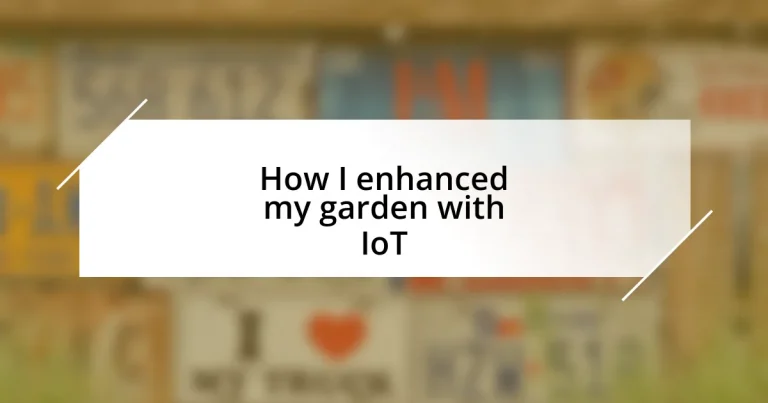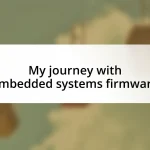Key takeaways:
- The integration of IoT in gardening enhances real-time monitoring of plant needs, fostering a deeper connection between gardener and plants.
- Understanding garden needs through sunlight exposure and soil conditions is crucial for effective plant care.
- Automation of watering systems, combined with IoT technology, significantly reduces manual labor and improves plant health.
- IoT technology empowers gardeners to shift from reactive to proactive care, optimizing resource use and contributing positively to the environment.
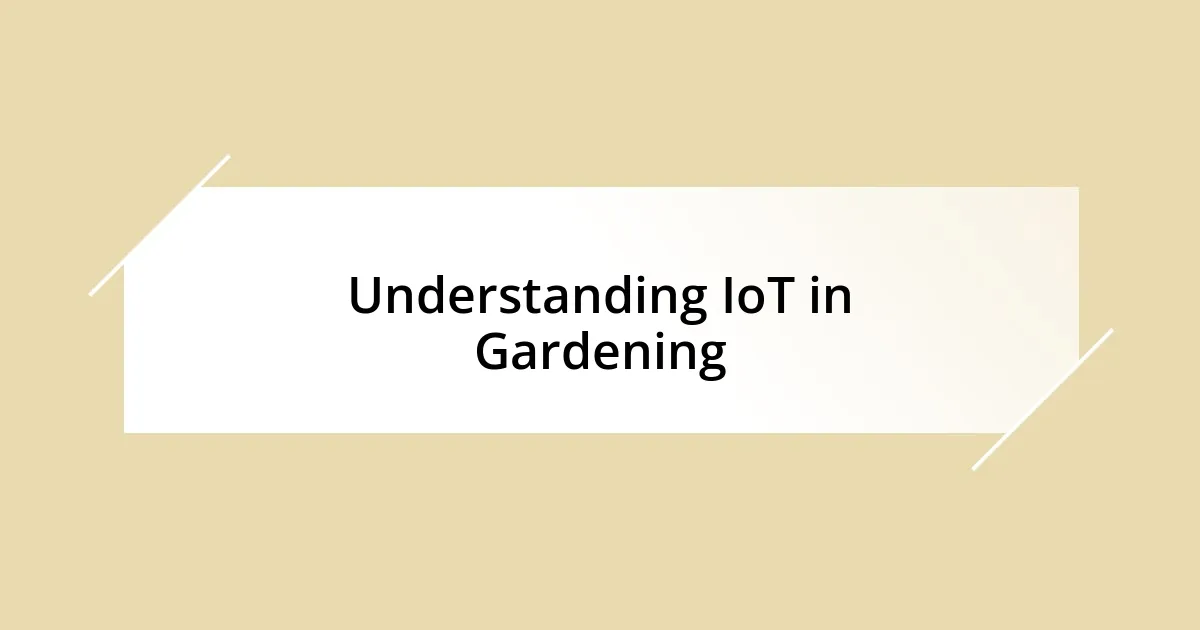
Understanding IoT in Gardening
In my experience, the concept of the Internet of Things (IoT) in gardening transforms how we interact with our plants. Imagine being able to monitor soil moisture levels and temperature from the comfort of your couch; this technology turns gardening into a more intuitive process. The real-time feedback fosters a deeper connection with my garden, prompting me to care for my plants based on their specific needs rather than a general schedule.
One of the most striking aspects of IoT gardening is the data collection that occurs. When I first set up my smart sensors, I was surprised to see how varying humidity levels significantly impacted plant growth. It’s fascinating—and a bit alarming—to realize just how much environment affects our green friends. Have you ever wondered if your plants are thriving or merely surviving? With IoT, you’re not left guessing; the answers are right in your hands.
Integrating IoT into my garden has brought unexpected joy and a sense of fulfillment. I remember the thrill of receiving notifications on my phone, reminding me when to water or alerting me to a sudden drop in temperature. It felt like having a green thumb, backed by technology, guiding me in my gardening journey. Who knew that little gadgets could stir such enthusiasm in my outdoor space?
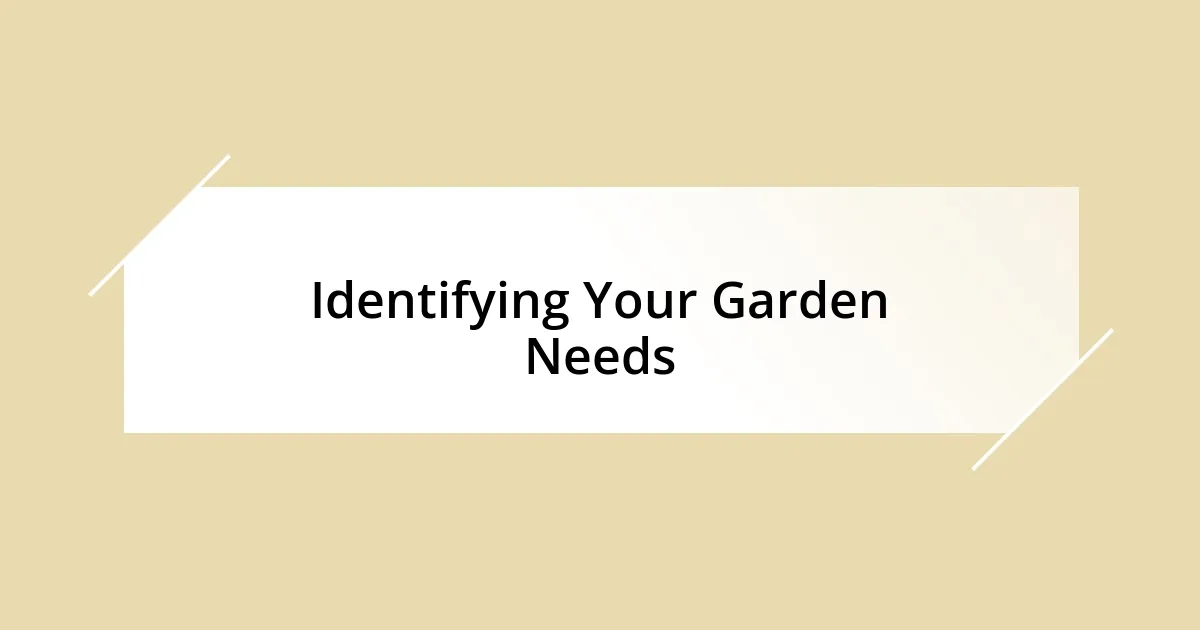
Identifying Your Garden Needs
Identifying your garden needs starts with an honest assessment of your space. I recall my initial efforts, where I overestimated the sunlight my garden received. After tracking sun exposure, I realized that some areas were shaded for most of the day, impacting the types of plants I could successfully grow. Taking a step back and observing the garden environment allowed me to tailor my plant selections more effectively.
Next, I found that understanding soil conditions was equally crucial. When I first introduced IoT sensors, I discovered the soil was too clay-heavy in certain spots, leading to poor drainage. This insight empowered me to amend the soil and create a more suitable environment for my plants. Have you ever come across surprising discoveries in your gardening journey? It can be quite enlightening to learn where your garden’s strengths and weaknesses lie.
Lastly, the emotional connection to your garden plays a significant role in identifying its needs. I love nurturing my plants, but when I became more attuned to their requirements through IoT technology, my gardening experience transformed. For instance, receiving a notification about a drop in soil moisture not only reminded me to act but also deepened my empathy toward the plants I cared for. This blend of technology and emotional engagement brings out the best in both gardener and plants.
| Aspect | Importance |
|---|---|
| Sun Exposure | Essential for determining suitable plants |
| Soil Conditions | Affects drainage and nutrient availability |
| Emotional Connection | Enhances the gardening experience through empathy |
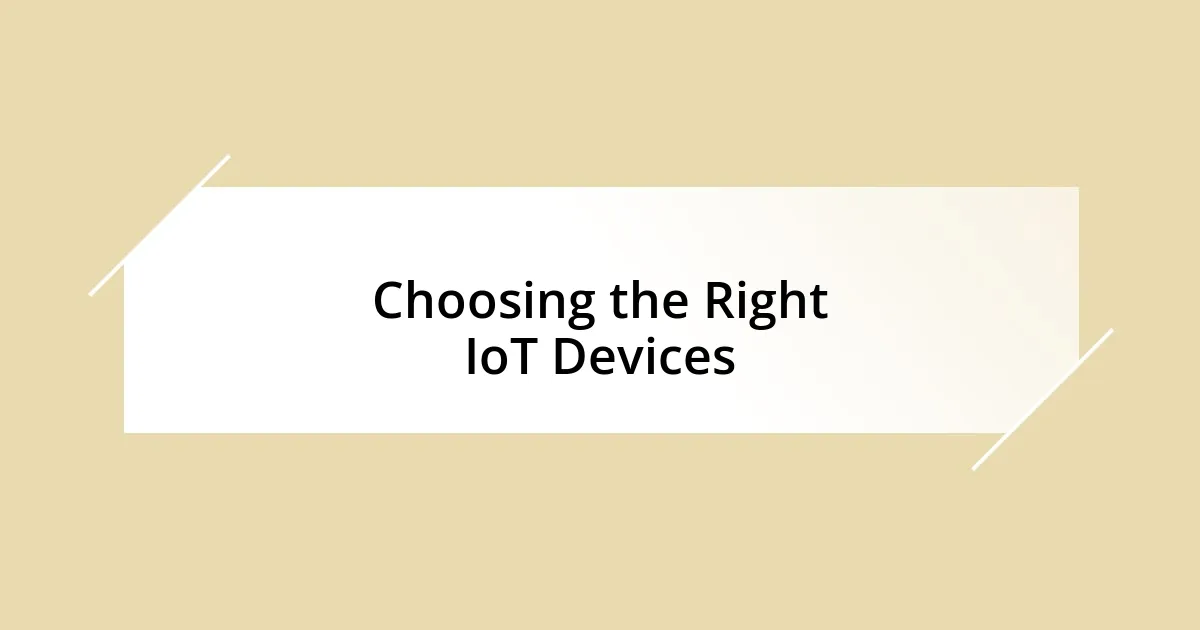
Choosing the Right IoT Devices
Choosing the right IoT devices for your garden can feel overwhelming at first, especially with so many options on the market. I remember when I started, I was drawn to flashy devices without fully understanding their specific functions. It quickly became clear that I needed to focus on devices that not only fit my gardening style but also genuinely addressed my garden’s needs. This approach allowed me to select equipment that would make a real difference in managing my plants effectively.
Here’s a brief checklist to consider when selecting devices:
- Purpose: Does the device serve a specific need, like soil moisture monitoring or temperature tracking?
- Compatibility: Will the device integrate with your existing smart home system?
- Ease of Use: Is the app user-friendly, and can it be easily navigated?
- Data Accessibility: Can you access real-time data and receive alerts on your phone?
- Durability: Is the device built to withstand outdoor conditions?
When I finally settled on a reliable moisture sensor, it felt like a game-changer in my routine. I loved how I could simply check my phone to see the soil moisture levels—no more guesswork or overwatering! Selecting devices that catered to my garden’s unique environment fostered a more intuitive gardening experience, something I truly cherish.
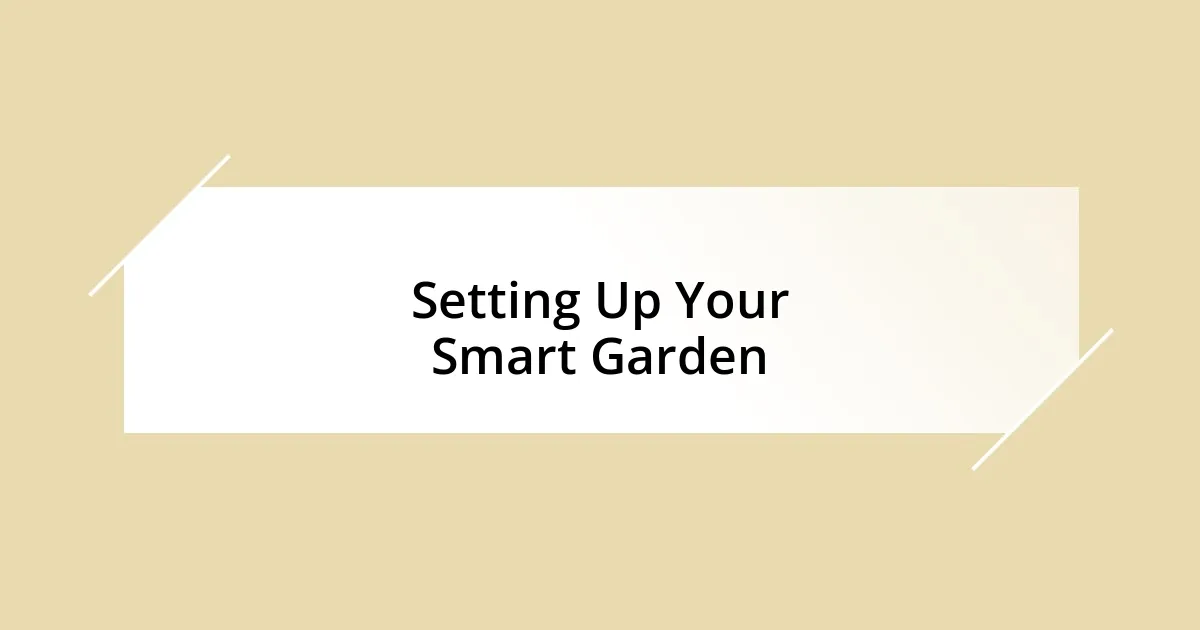
Setting Up Your Smart Garden
Setting up your smart garden was a journey that began with laying a solid foundation. I personally found that starting with a well-thought-out layout made all the difference. When I first organized my planting areas, I created sections dedicated to different plants based on their sunlight and water needs. This tailored approach not only optimizes space but also makes integration with IoT devices, like moisture sensors and temperature monitors, much more effective. Have you ever considered how your garden layout could enhance your plant care?
Once the layout was determined, I tackled the installation of my IoT devices. This step takes some planning, especially when it comes to positioning sensors for optimal data collection. I vividly recall placing my soil moisture sensor near a particularly thirsty plant and realizing just how much it appreciated being in the right spot. It’s almost like giving your plants a voice! Monitoring their needs became a seamless part of my routine, allowing me to respond quickly when they required attention.
Finally, connecting my IoT devices to the app was where the magic truly unfolded. I remember the excitement I felt seeing real-time data on my smartphone, which truly opened my eyes to what my plants were experiencing. This connection enhanced my gardening experience by transforming it into a more interactive relationship. It’s fascinating to think—how often do we overlook the silent needs of our plants? Embracing technology in this way has made me much more attentive and responsive to my garden’s health.
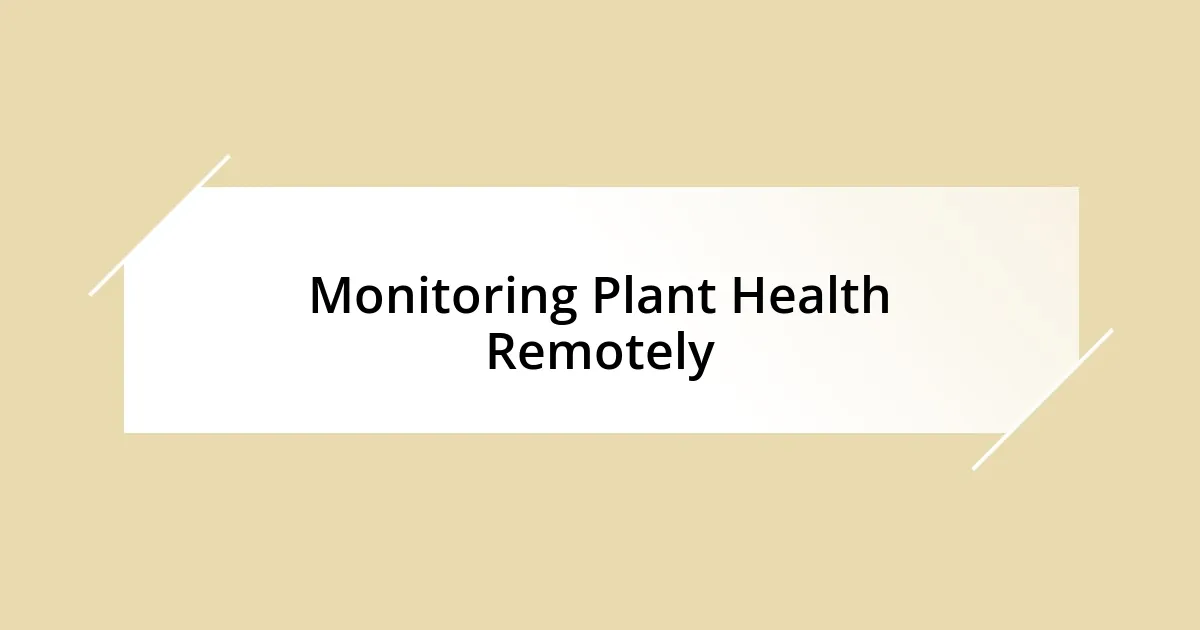
Monitoring Plant Health Remotely
Monitoring plant health remotely has completely revolutionized the way I interact with my garden. I once spent countless hours guessing when my plants needed water or attention, but now, I simply glance at my phone. One evening, I received an alert from my moisture sensor about a drop in soil moisture—suddenly, I was reminded of how vulnerable those green friends are. It felt empowering to know I could respond immediately and prevent any wilting or stress.
The real beauty of remote monitoring lies in its ability to provide insights I never would have noticed otherwise. For instance, I remember the first time I viewed the temperature data in real-time; it was a chilly September night, and I hadn’t even considered how it might affect my tropical plants. Aligning my actions with the data from my IoT devices made me feel like I was genuinely partnering with nature, rather than just trying to reign over it. Isn’t it fascinating how technology bridges that gap, bringing us closer to understanding our plants’ needs?
Sometimes, I find myself pondering just how much I was missing before integrating these smart devices. I used to feel frustrated when a plant suddenly started drooping, unsure of the culprit. Now, with the remote monitoring in place, I can track patterns and respond proactively instead of reactively. Engaging with my garden has transformed from a chore into an enriching experience—one where every notification feels like a gentle nudge reminding me to care for my thriving little ecosystem.
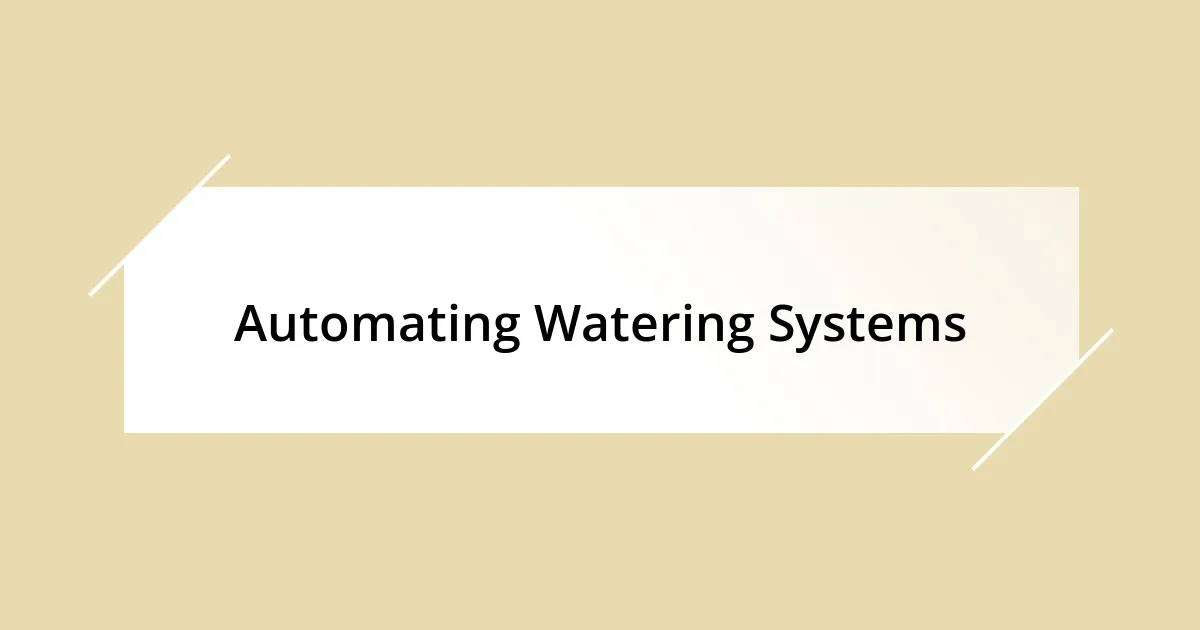
Automating Watering Systems
Automating my watering system has truly changed the way I care for my garden. I remember when I first set up the drip irrigation system connected to my moisture sensors; it felt like I was giving my plants a steady hand of support. The best part? No more worries about overwatering or under-watering. Have you ever watched a garden thrive when it receives just the right amount of water? It’s a sight that brings an immense sense of satisfaction.
Initially, I struggled to find the balance between manual watering and automation. One summer afternoon, as I stood sweating in the sun with a hose in hand, I thought, “There has to be a more efficient way.” After a bit of research, I decided to install a smart sprinkler system that could be scheduled and adjusted based on real-time weather data. Let me tell you, witnessing my garden flourish without the guesswork was like watching a masterpiece come to life, stroke by stroke!
What surprised me the most was how the automation not only saved time but also enhanced the garden’s health. I’ve seen my tomatoes and peppers grow more robustly, and I couldn’t help but deem it nothing short of a miracle. Imagine waking up to a garden that’s perfectly hydrated, without the hassle of daily chores. Isn’t it incredible how a few smart tools can lead to such a transformation, making us more connected to nature while allowing our green spaces to flourish? With every season that passes, I find new joy in the simplicity and beauty of an automated watering system.
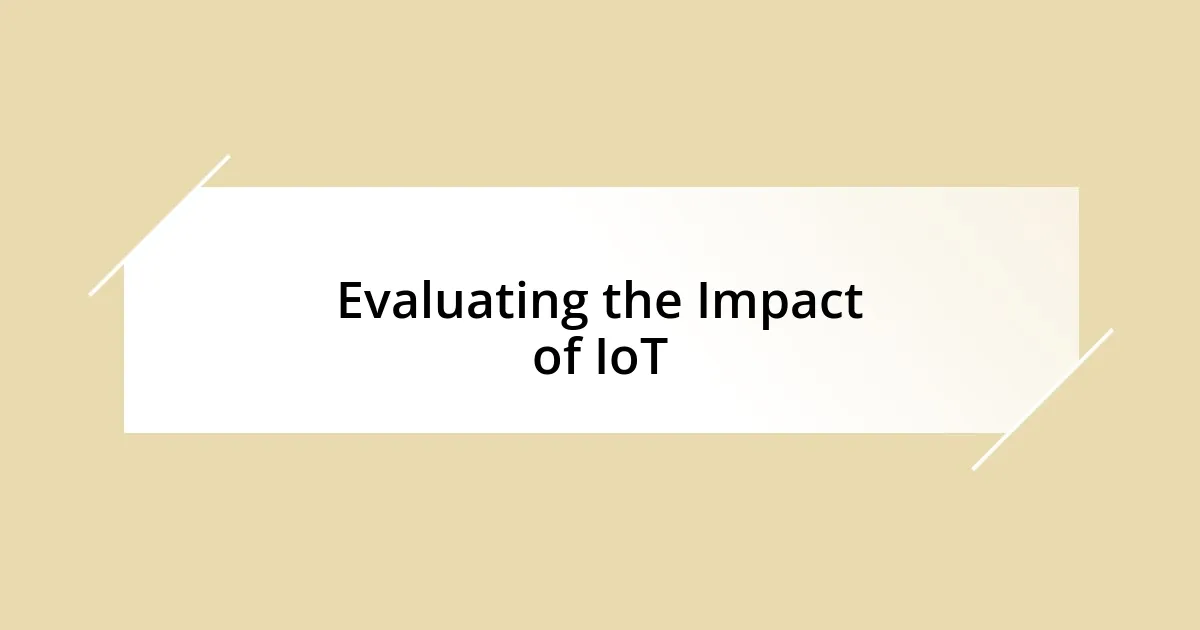
Evaluating the Impact of IoT
Evaluating the impact of IoT on my garden has been eye-opening. At first, the data felt overwhelming, like drinking from a fire hose, but as I began to analyze the information, patterns emerged. For example, I noticed how certain plants thrived under specific humidity levels, which encouraged me to experiment with micro-climates in my garden. Isn’t it thrilling to realize that the tiniest adjustments can result in healthier plants?
I often reflect on how IoT has shifted my gardening mindset from reactive to proactive. There was a time when I’d rush out to check for drooping leaves, but now my sensors alert me before any visible signs appear. It’s like having a crystal ball for my garden; the ability to anticipate needs instead of simply reacting to them has not only saved me time but has also fostered a deeper relationship with my plants. Have you ever felt that rush of excitement when you understand something new about your garden?
Looking at the numbers has transformed how I allocate my resources, such as water and fertilizer. For instance, by closely monitoring moisture levels, I discovered I could reduce my water usage by nearly 30% without compromising plant health. This realization hit home for me—each time I see my flourishing garden, I can’t help but feel proud knowing I’m making a positive impact not just for my plants, but for the environment too. Isn’t that a powerful motivator to embrace technology in our gardening practices?












